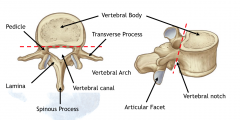![]()
![]()
![]()
Use LEFT and RIGHT arrow keys to navigate between flashcards;
Use UP and DOWN arrow keys to flip the card;
H to show hint;
A reads text to speech;
14 Cards in this Set
- Front
- Back
|
Four principal curves |
Cervical (Lordosis ventral) Lumbar (Lordosis ventral) Sacral (Kyphosis dorsal) |
|
|
Typical vertebra parts. Transverse process (muscle attachments) |

|
|
|
cervical 1-7 |
bifid spinous process (2 heads). Small transverse foramen, triangular vertebra foramen |
|
|
thoracic t1-12 |
facet that articulates with rib tubercle. small vertebral foramen. Articulate with ribs. Long spinous process |
|
|
lumbar 1-5 |
broad and quadrilateral. spinous process thick, broad , quadrilateral. laminae broad and short |
|
|
sacral wing s1-s5 |
fused facet for articulation with pelvis |
|
|
coccygeal |
4 parts has coccygeal cornu |
|
|
INtervertebral discs |
secondary cartilaginous joints. not present between c1 c2. and scarum cocyx. made up of outer fibrous anulus fibrosus and inner fibrogelatinous nucleus pulposus |
|
|
atlanto axial complex |
articulation between base of skull overtebra one and 2 |
|
|
vasculature |
dominant nutrient artery and extensive vascular network withc allows bone blood to drain |
|
|
ligaments |
anterior logitudinal and posterir longitudinal. two largest ligaments |
|
|
kyphosis |
hunchback |
|
|
lordosis |
pregnancy |
|
|
scoliosis |
lateral deviation |

